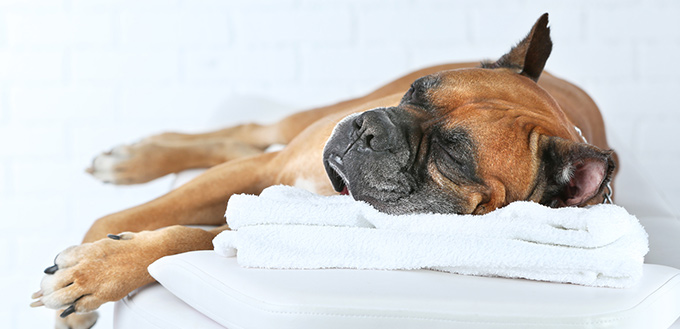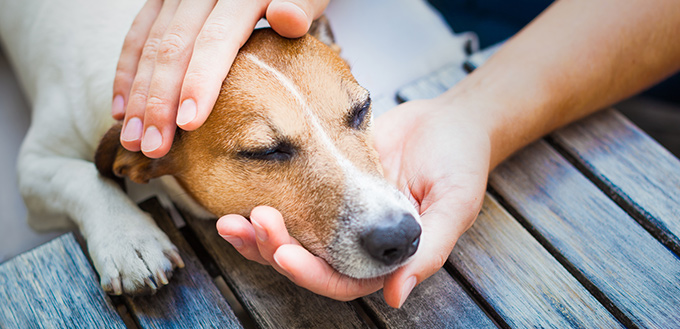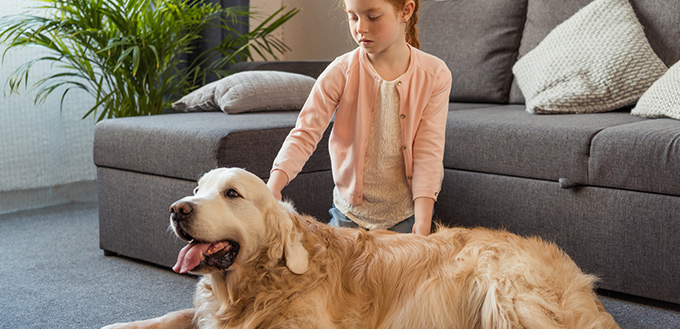Massage is one of the many alternative healthcare modalities that are now gaining popularity in the care of a variety of pet conditions. Not only is massage great for soothing tired, twisted, and aching muscles, it is also beneficial in providing a calmer and more relaxed body. For dogs this can easily translate into absolute bliss. For pet parents, massage is an opportunity for them to bond well with their pets and learn more about the bodies of their furry friends. It is, thus critical that pet parents know how to properly massage their dog. You don’t need a degree for that. You only need to read what we have in store for you.
Getting Ready for the Massage
Like all other activities involving your canine friend, it is imperative that you observe a few rules whenever you are going to massage your pet. First, it is important to schedule the massage when your dog is at its most relaxed state of mind. For many pet parents, this is typically after dinner towards the end of the day. It is imperative that your dog is calm before you even start giving it a massage. It will also help to find a quiet spot in your house upon which to perform the massage. It should be quiet and free from any distractions. Talk to your dog in a calm, reassuring voice.

Start with Gentle Petting
Always start by gently petting your dog in areas where you know it loves best. Some dogs love to be petted under the chin just at the junction of the jaw and the neck. Some love their backs being caressed while others like their heads to be stroked. Gentle petting gets your pet ready for the massage. Make sure to run your hands all over your dog’s body, ensuring that your touch is not yet that pressure-laden. Include its tummy, its back, and even its legs using slow and gentle strokes. This familiarizes your pet to the sensation of your touch. Always speak softly to your dog while you’re petting it. This gives it reassurance that you’re actually there helping it feel more relaxed.
Start Massaging Your Dog’s Neck
From gentle petting, gradually increase the pressure that is exerted by your hands. Go slow and even so that your dog will not get all too tensed and for it to relax even further. The idea here is to start with strokes that are a notch higher than simple petting and a level lower than actual massaging. If your pet doesn’t flinch or doesn’t stiffen, then you can proceed with the massage itself. Move your fingertips in a circular motion at the back of your dog’s neck. For smaller dogs you can make smaller circular motions. Likewise, larger dogs will require larger motions. Keep an eye on your dog’s reaction. It is a must that it remains calm and relaxed. If not, then you’re exerting too much force that your pet is already uncomfortable.
Massage Your Dog’s Shoulders
From the neck work your hands all the way down until they reach your dog’s shoulders. Spend more time in this body part since this is just a few of those body areas that dogs cannot reach themselves. Try using a combination of circular movements of your fingertips and longer strokes. Take note of muscle groups that ‘feel’ tense. You can easily identify them by differentiating between areas in your dog’s shoulders. There will be areas wherein the tissues seem soft to the touch that they ‘give’ with your finger or hand movements. There will also be areas where the tissues seem to push against your fingertips. Take note of these areas and try to work on them, attempting to ‘break down’ the ‘hard’ areas. Be mindful of your dog’s reaction, though.

Massage the Chest and Front Legs
Not all dogs love having their limbs being touched, especially those near the paws. These actually don’t have dense muscles so it can be quite uncomfortable for dogs. If such is the case then move up a little bit and massage only that part of the legs that have ample muscle mass. You may want to use both hands to work on each leg as if pinching the sides of the legs. Be careful not to hurt your dog, though. If your pet likes being massaged in its legs, you may also want to include its paws. Work your way towards your pet’s chest and massage the region using the same circular movements of your fingertips. You can also use your palms to massage the entire area in one go.
Massage the Back
From the front legs and chest, work your way back up to your dog’s shoulders. Slowly run your hands across the entire length of your dog’s spine. Use circular movements of your fingertips to work the muscles on opposite sides of the spine. Be mindful of the reaction of your pet. If it flinches or lets out a growl, then you’re overdoing it. Work your fingers down towards its belly region, avoiding applying too much pressure. Work your way up towards its spine again. Cover the entire length of its back as well as the corresponding region on its belly.
Massage Your Dog’s Hind Legs
If you massage your dog’s back in a methodical manner, you’ll eventually end up at the base of its tail. From here you can start massaging its hind legs beginning with its hips, working your way towards its lower legs and paws. Use circular motion in working the muscles of the hips, alternating it with gentle longitudinal strokes. Do the same with your dog’s lower legs until you reach its paws.
Consider the Long Strokes Method of Massaging Your Dog
If you don’t like using circular motions in massaging your dog, there is another way. You can use the palm of your hands to gently yet firmly press against your dog’s skin. Run your hand from your dog’s nose through its head, along the side of its spine, and terminating at the paws of your dog’s hind legs. Make sure to keep your hands about an inch or two from the spine. Use the same motion following the long axis of your dog on the other side of its body. Once you’re done with the long axis, you can start massaging your dog’s body in sections using the same open-hand massage technique. Start at near the spine and run your open hands towards the bottom. For example, you can run your hand from the back of the neck towards the front of the throat then work your way towards its bottom, terminating at the hind legs.
Some Helpful Tips to Improve Your Dog Massaging Techniques

Massaging your dog takes a bit of getting used to, both for you and your pet. However, there are certain things you can do to help improve your massage sessions.
- Don’t massage your canine friend if it is ill, sick, or tired. For instance, if your dog is still hyped up from a particular activity, you will need to calm him down first.
- Always pay special attention to behavioral cues from your dog. If its muscles suddenly become tense with your touch, stop what you’re doing. If it flinches or even growls, it means your dog is not happy with the way you’re touching it. Be mindful of subtle cues that your pet may exhibit during massage sessions. The idea is for your pet to learn to associate massage with something that is really good and pleasurable, not something painful and uncomfortable.
- Always start with relatively brief massage sessions, say about a minute or so. If your dog likes the massage, you can gradually increase the length of time of each massage session.
- Consider maximizing the opportunity while your dog is already relaxed. Because one of the goals of massage is to relax your dog, you might want to include grooming as part of its massage. However, it is imperative that your pet loves being groomed. If not, you run the risk of your dog associating massage time with anxiety and discomfort.
- If your pet happens to have arthritis, avoid massaging the joints directly. What you can do is to massage the surrounding areas. You can also employ a kneading motion instead of the circular motion to help loosen up tight muscles and improve the range of motion of the joints. Additionally, you may also want to gently stretch and bend your pet’s legs to improve range of motion while also easing pain.
- Massage gives you an opportunity to assess and understand your dog’s body. Take note of any areas that may be inflamed. Steer clear of these but do note their location. The same is true with lumps, bruises, or any other ‘abnormalities’ on your dog’s skin. Consult with your vet regarding your observations.
Massage can provide a host of benefits for our dogs. It is therefore very important that you know how to perform the massage on your dog in the correct manner so you can be assured of all the benefits.
Sources:
- Dr. Kevin Fitzgerald, How Massage Can Help Your Dog – The American Kennel Club
- The Basics of Canine Massage and Chiropractic – AKC Canine Health Foundation
Note: The advice provided in this post is intended for informational purposes and does not constitute medical advice regarding pets. For an accurate diagnosis of your pet's condition, please make an appointment with your vet.






